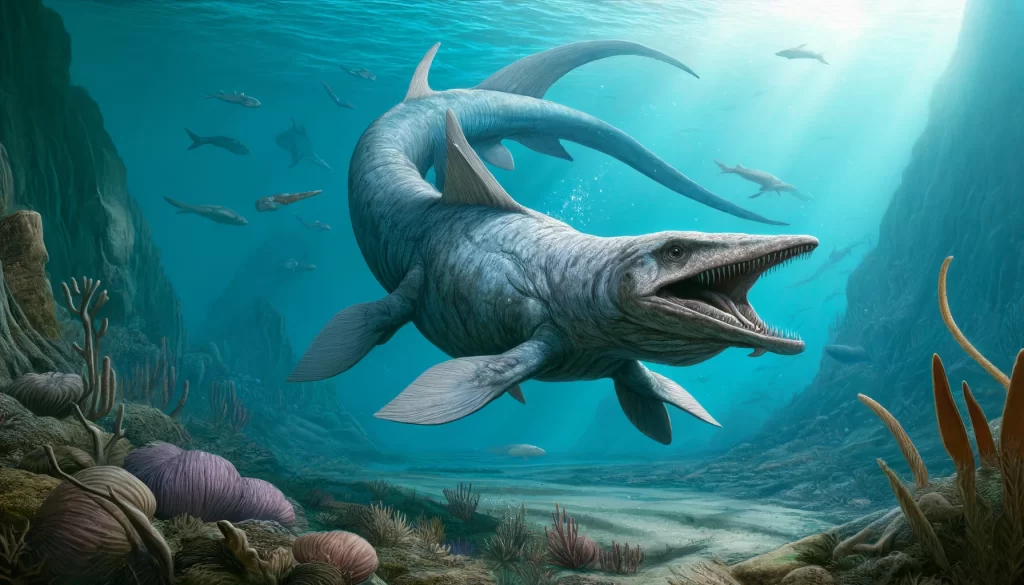In the spring of 2020, an adventurous day trip to Blue Anchor, a quaint seaside village in Somerset, southwest England, turned into an extraordinary discovery for 11-year-old Ruby Reynolds and her father, Justin Reynolds. Their purpose was to explore the beach for fossils, a common pastime for many who visit the area due to its rich prehistoric deposits.
Upon their arrival, Justin immediately noticed a four-inch piece of fossilized bone left at the top of the beach. He was thrilled, as it was larger than any bone he had previously found. “So I was very excited and sat down to have a good look at it,” he recalls. While her father examined their first find, Ruby continued to search the area. Her efforts paid off when she spotted a second piece of bone, half-buried in a mud slope. This specimen was even more exciting because it was twice as long as the first and in much better condition. “It was just sort of lying there,” Ruby remembers. “I was just happy, really.”
Little did they know, these pieces were part of the largest marine reptile ever discovered—a giant ichthyosaur from the Triassic Period, about 202 million years ago. Ichthyosaurs dominated the prehistoric oceans, resembling large, robust sharks with elongated, tooth-filled snouts and four flippers. Dean Lomax, a paleontologist affiliated with the University of Bristol and the University of Manchester, explains, “These are reptiles only very, very distantly related to things like crocodiles.” Interestingly, ichthyosaurs shared several traits with modern whales, such as giving birth to live young and fully adapting to aquatic life without returning to land.
This newly identified species, named Ichthyotitan severnensis, is believed to have measured approximately 82 feet in length—roughly twice as long as a school bus, according to a study published in the journal PLOS ONE. “There were things that we can’t even possibly imagine in the past,” notes Kelsey Stilson, a biomechanist not involved in the study, “But we can get little hints. And this is one little hint at this larger picture” of Earth’s evolutionary history.
The story of Ichthyotitan severnensis began nearly eight years before Ruby and Justin’s discovery. Paul de la Salle, an enthusiastic amateur fossil collector, was scouring a beach in Lilstock, Somerset, when he stumbled upon several pieces of fossilized bone. He showed these to Lomax, a friend and professional collaborator. They realized these fragments fit together like pieces of an ancient, prehistoric jigsaw puzzle, forming part of a jawbone of an ichthyosaur. However, the discovery was incomplete and somewhat eroded, leaving many questions unanswered.

Hope lingered that more specimens would eventually surface. “What we’d hoped for — we kept our fingers crossed — we hoped that maybe more specimens would come to light in the future,” Lomax remarked.
That hope was realized with Ruby and Justin’s discovery in 2020. They contacted Lomax, excitedly suggesting that they might have found another giant ichthyosaur jawbone. Lomax reviewed the images they sent and confirmed their identification. Encouraged by the preservation of the Reynolds’ fossils, he organized more collection trips to Somerset, which led to the recovery of additional fragments of the same jawbone.
The second specimen was nearly twice as complete as the first, boosting the confidence of Lomax and his team that they had indeed discovered a new species, which they named after the Severn Estuary near its discovery site. Although a complete skeleton has not been found, if Ichthyotitan severnensis had been proportioned like other ichthyosaurs, it would have been truly massive, possibly as large as a blue whale.
The Triassic Period, the era of Ichthyotitan severnensis, was a pivotal time in Earth’s history. It saw the emergence of early mammals and dinosaurs. “That’s when you see the first very early mammals and the first very early dinosaurs,” says Stilson. “Everything’s starting right then.”
The period ended with a mass extinction event, which wiped out many species, including Ichthyotitan severnensis. This marked the end of an era where no marine reptile would ever reach such gigantic sizes again. Some ichthyosaurs survived into the Jurassic and Cretaceous periods, but these were smaller and eventually went extinct about 94 million years ago, leaving a niche that would later be filled by mammals, including the ancestors of modern whales, which transitioned from land to sea.
This article is based on the following article:
https://www.npr.org/2024/05/06/1248523748/father-daughter-find-ichthyosaur-largest-marine-reptile

Background Information
This comprehensive background can provide readers with the necessary context to better understand the significance of the discovery of Ichthyotitan severnensis and how such findings contribute to our understanding of the history of life on Earth.
1. Paleontology
Paleontology is the study of ancient life, from dinosaurs to microscopic organisms, through the examination of fossils. Fossils are the preserved remains or traces of organisms that lived in the geological past. There are various types of fossils, including bones, shells, imprints, and traces like footprints. Paleontologists use these fossils to understand evolutionary processes, environmental changes, and how ancient ecosystems might have functioned.
2. Marine Reptiles and Ichthyosaurs
Marine reptiles are a diverse group of reptiles that have adapted to living in marine environments. This group includes modern-day sea turtles and saltwater crocodiles, as well as extinct forms like mosasaurs, plesiosaurs, and ichthyosaurs. Ichthyosaurs, specifically, were highly adapted marine reptiles that resembled modern dolphins in shape and presumably in lifestyle. They were not dinosaurs but lived during the same periods. Key characteristics include a streamlined body, large eyes (indicating good vision), and limbs modified into flippers.
3. Triassic Period
The Triassic Period (about 252 to 201 million years ago) is the first period of the Mesozoic Era and follows the largest mass extinction at the end of the Permian Period. The Triassic is known for the recovery of ecosystems after this extinction, the rise of dinosaurs, and the first appearance of mammals. The oceans were repopulated with new forms of life, including the ichthyosaurs. Understanding this period helps in grasping the significance of the ichthyosaur as it highlights the rapid evolution and diversification of life forms following a mass extinction.
4. Fossilization and Fossil Hunting
Fossilization is a rare occurrence, as it requires specific conditions to preserve the remains of organisms. Most commonly, the organism must be quickly covered by sediment. Over millions of years, the organic material is replaced by minerals, turning it into rock. Fossil hunting involves searching for these fossils in sedimentary rocks. This can be done professionally or by amateurs, and significant discoveries can still be made by non-scientists.
5. Geological Time Scale
The geological time scale is a system of chronological dating that relates geological strata (stratigraphy) to time. It is used by geologists, paleontologists, and other Earth scientists to describe the timing and relationships of events in geologic history. Students should understand that the Earth is very old—about 4.6 billion years—and that the time scale is divided into eons, eras, periods, epochs, and ages.
6. Extinction Events
Extinction events are periods in Earth’s history when a large number of species die out in a relatively short time. The end of the Triassic Period, for instance, included a significant extinction event that paved the way for the rise of the dinosaurs in the Jurassic. Understanding these events helps explain the rise and fall of various groups of animals throughout Earth’s history.
7. Adaptation to Aquatic Life
Some terrestrial organisms have returned to the water over the course of evolution, such as ichthyosaurs and later, whales. These transitions involve significant adaptations, such as changes in body shape to be more hydrodynamic, modifications of the limbs into flippers, and the development of new methods for breathing, such as a blowhole in whales.

Debate/Essay Questions
- Is it ethical for private collectors to keep fossils, which are part of our natural heritage, or should all fossils be public property to ensure they contribute to scientific knowledge?
Please subscribe to Insight Fortnight, our biweekly newsletter!
